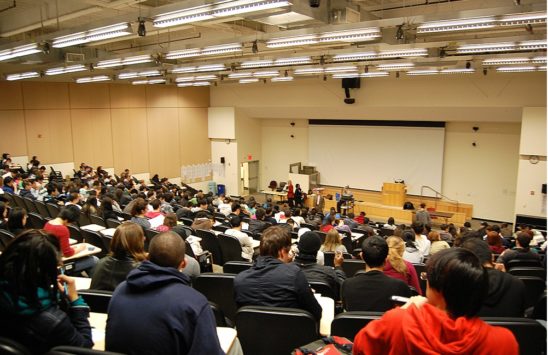I really do not envy those university and college administrators trying to work out what to do for this coming fall semester. This will vary in any case from jurisdiction to jurisdiction, even within the same country, depending on the status of infection in October.
However, I thought it might be helpful to provide some guidelines about online and blended learning based on past experience that might be taken into consideration before making any final decisions – and a few crazy ideas about how to manage in October.
Freshman/1st year classes
This to me seems to be the biggest challenge, for several reasons.
Sex, sport and hell-raising
Students go to university or college for many reasons, not all of them by any means academic. Particularly for young people coming out of high school, the social and cultural aspects of college are equally important.
Being asked to take their first courses fully online at a new institution will be a very disappointing experience. We have already seen students in many jurisdictions balking at paying full tuition fees for what they consider to be a different experience from what they were hoping for.
However, this might be just acceptable for one semester – tough, guys, you just happened to be unlucky.
Dependent learners
The second problem though is that many students coming from high school are still pretty dependent learners. Unless they have been able to take a couple of online courses in their last years at high school, they will have no experience of studying independently (although many will have had a crash course over the summer, which, because such courses could not be properly designed, will have already soured them to the experience.)
Independent learning is a skill, and like most skills, you need to start slowly and carefully. Suddenly being thrown into ten courses online is not the best way to go. Many will sink, although some will certainly swim. However, experience tells us that graduate, older and lifelong learners all do much better in online learning than undergraduates.
Blended learning – a mix of face-to-face and online – though is a very good way to ease gently into online learning. Introducing online or digital learning gradually in first year, supported by face-to-face classes, is a much better strategy.
The problem with large lecture classes
However, the biggest problem for first year students next October will be the very large lecture classes. Allowing 200 students or more into one room may not be possible purely for social distancing reasons. But moving these courses online has a number of really challenging problems.
As with much else, Covid-19 is highlighting a major weakness in the system that existed beforehand, but which no-one really wanted to address. Why do we have such large lecture classes for first-year students? Mainly because faculty don’t want to teach them. They may be necessary, but they are boring – not leading edge, just basic stuff that has to be learned for later years. Also, by loading up first year classes, instructors get to teach less, and get smaller classes at graduate and third and fourth year level.
Well, that’s probably not going to be possible in October unless you are willing to risk spiking a return of Covid-19 in your institution. Even if students can come back to campus, you will need to avoid these large lecture classes.
However, putting them fully online is not a good solution, either. Some people, such as Alex Usher, have argued that we should take the opportunity to develop a series of ‘national’ first year online courses that could be shared across institutions. This is not a bad idea, except such courses already exist: they are called either MOOCs or open educational resources. Certainly a national program might increase the quality but you are still going up against Harvard, MIT, Stanford and other elite universities whose online lectures are freely available. It will also take more time than there is available to get agreement, share resources and develop the Canadian national courses.
In any case, content is not the problem: that’s all out there on the web. Students just have to find it. What’s not out there on the web is learner support and quality assessment, particularly of high level skills, such as critical thinking, problem-solving, evaluation and application. That kind of learner support is relatively labour intensive.
Furthermore for quality feedback and assessment the labour needs a relatively high level of subject expertise, even or especially for first year courses. This kind of feedback and assessment will not be possible by just one instructor with more than 200 students. Given also that even in the best of times, instructors are stretched, and since appropriate content for first year courses is already available on the web if you know where to look, instructors would be better using their limited time on developing appropriate online activities for learners and feedback rather than on delivering the same lectures by Zoom.
What is needed then is not just an alternative delivery method – online for lectures – but alternative teaching methods that focus more on knowledge management and skills development and less on content delivery and testing. October provides a real opportunity to increase the quality of these large first year courses, from necessity as much as from desire.
An alternative approach
Let’s treat the fall semester as a one-off large experiment. Maybe things can revert to normal in January but for October we need to radically rethink how we provide programs overall.
Move many graduate and fourth-year undergraduate courses online
The most appropriate courses to move online for one semester would be many masters programs, especially theory and research methods courses. These students usually have very good study skills, and are relatively independent learners, and indeed are likely to need less learner support than first year students. Next in line would be some of the more popular fourth year undergraduate theory or project-based courses.
In Canada, most institutions already have some online courses in these areas. It’s not like starting from scratch but replicating already successful models of online course design and delivery. Indeed, there may be value in extending such online courses for many students beyond the fall semester. All we are doing here is accelerating the direction in which many institutions, at least in Canada, are already moving.
One advantage of this is that it will free up more classrooms for the incoming first year students.
Use open educational resources for content
Provide first year students with a list of appropriate sources of content for the first year class, and also encourage them to find their own resources. Use your instructors primarily to help students to find, analyse, evaluate and apply what they find.
Smaller sections for first year students
Try to break the large lecture classes into smaller sections and spread them out across the university using classrooms/facilities normally used by fourth year and graduate students now studying online.
All hands on deck
Just for the fall semester, throw as much as possible of your instructional resources at these first year courses. Put your senior professors in charge of designing/managing the first year courses. Use off the shelf ‘open’ online courses for content delivery. Get all instructors and graduate students involved in providing support for these classes. This may mean cancelling all non-essential research, increasing teaching loads, and getting senior professors teaching first year students – remember, this is an emergency. Aim for one support instructor for every thirty first year students (this could include graduate students as paid adjuncts).
Blended learning
Mix face-to-face sessions – preferably seminar-type or practical work – with online study, roughly two-thirds face-to-face and one third online. This again will enable smaller classes across more rooms, and will help students begin to manage online learning for themselves. Make sure though that any online activities are completed and followed up in the face-to-face sessions.

Use Zoom lectures sparingly
Use Zoom for
- an introductory lecture;
- a half-way, ‘taking stock’ lecture;
- and a course wrap-up lecture.
The introductory lecture should explain the course strategy, student responsibilities, how assessment will work, and how support will be provided to students.
Conclusions
My approach may not be possible but there is no perfect solution if Covid-19 is still hanging around in October. Now is the time to be making plans and arrangements for a partial return to campus and social distancing for teaching.
However the worst group of students to put fully online are first year students. Class size is too great, they have the least motivation to study online, but above all providing the necessary learner support for them to succeed online will be impossible.
Any solution means a radical look at the organisation and design of first year classes – and about time.
All I can say is that I m so glad not to be taking first year classes this October – or having to organise them. So I wish you all the best for October.











 Dr. Tony Bates is the author of eleven books in the field of online learning and distance education. He has provided consulting services specializing in training in the planning and management of online learning and distance education, working with over 40 organizations in 25 countries. Tony is a Research Associate with Contact North | Contact Nord, Ontario’s Distance Education & Training Network.
Dr. Tony Bates is the author of eleven books in the field of online learning and distance education. He has provided consulting services specializing in training in the planning and management of online learning and distance education, working with over 40 organizations in 25 countries. Tony is a Research Associate with Contact North | Contact Nord, Ontario’s Distance Education & Training Network.

